Engagement Ring - In Progress
Setting
Stone
Limited Time! Purchase any Engagement Ring and Receive a $250 Gift Card & Premier VIP Bundle.
We guarantee that every single purchase directly impacts one person's life by giving them access to clean water.
Looking for something unique? A black diamond engagement ring is a new take on tradition. From trendsetters after Carrie Bradshaw’s own heart, to rebels like Carmen Electra, all sorts of women love the sophistication and edginess of black engagement rings! But what exactly is a black diamond? And how do you pick the right one? Well, it depends on what you’re going for. Here are 8 things to know when looking for a black engagement ring!
A black diamond engagement ring features a black colored diamond center, typically surrounded by smaller white diamonds! Black is considered a “fancy” color diamond, outside of the normal color range. It is a unique choice for couples that want a fashionable, deco, or gothic engagement ring. Because of their unique characteristics and great price points, many black engagement rings have very large center stones.
Yes, but not in the way a white diamond does. That’s because, unlike white diamonds, black diamonds are not see-through. As a result, these black gems glitter with a metallic kind of shine, instead of a refractive firework sparkle.
Yes! And there are several types. Natural blacks, treated black colored diamonds, and lab created black stones!
It’s true! Natural black colored diamonds do occur in the earth! However, they are fairly rare. Interestingly, natural blacks are actually a form of normal, colorless diamonds that have an abundance of carbon inclusions. In other words, they are white diamonds born with LOTS of birthmarks! Under magnification, these birthmarks look like tiny clusters of small black dots and webs which are called “clouds.” Natural diamonds which have some of these black clouds, but not enough to make them wholly black, are called “salt and pepper” diamonds!
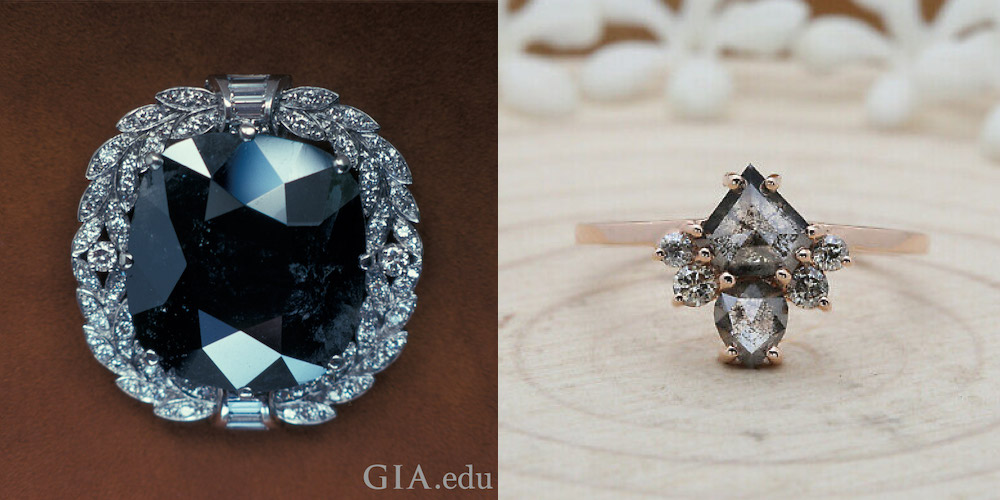
Left: Natural black diamond.| Right: Salt and pepper diamond.
Another type of black diamond engagement ring is one in which a natural white diamond has been “treated” in order to make it black. This is more common than a naturally-occurring black. In fact, most black gems sold today are treated in some way. There are two main ways scientists treat diamonds in order to produce black color. Both begin with less-attractive natural diamonds. And which method a gem scientist uses to turn the gem black depends upon why the original diamond is unattractive.
Gem Geek Moment: Natural diamonds which have way too many fractures and inclusions are turned black by being heated to incredibly high temperatures, which cause the fractures to “graphitize.” On the other hand, natural stones which begin as an unattractive color are irradiated, causing a black color to be deposited on-top of the less pretty color. Both of these treatments are safe and permanent. In addition, treated stones are less expensive and more uniformly black in appearance than natural stones!
A treated natural black diamond
Diamond scientists also make black diamonds in labs! There are two main types of Lab stones: those that are actually a very dark brown or dark blue (not actually “black”), and those that begin as less attractive colorless diamonds and are irradiated (just like their natural cousins)! Importantly, there is no difference in chemical makeup between natural diamonds and lab diamonds. They are both a 10/10 on the hardness scale. Also, there is no visual difference between a natural and a lab diamond which has been irradiated black. On the other hand, gemologists (and very studied consumers, like you!) may be able to distinguish the very dark blue/brown lab diamonds upon close inspection.
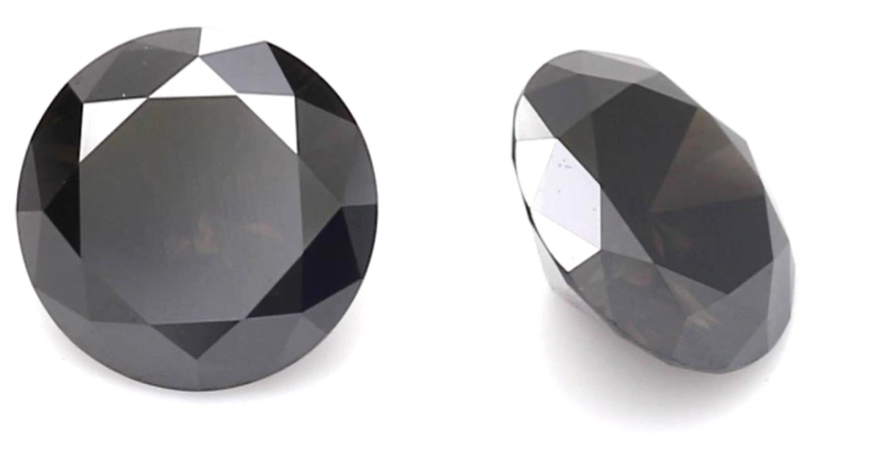
Lab black diamond (dark brown upon inspection)
Great question. It depends on whether you want a natural stone, a treated stone, or a lab stone. Black is considered a “fancy” colored diamond, and so they are the most expensive category (however, they are still much less expensive than white diamonds of the same size!). Lab blacks come next. Then, finally, treated diamonds. Why are treated diamonds the least expensive, you ask? The answer is that they started out as diamonds which otherwise wouldn’t sell. So, you’re getting a great value!
| Premium Natural Black | Irradiated Black | Lab Black | |
| Price Per Carat | $1,000-$3,000/carat | $300-$1,500/carat | $700-$1,000/carat |
Unlike white diamonds (in which the most important “c” of the four c’s is cut), when choosing a black diamond, the most important thing is clarity. I know what you’re thinking. “Hey! You just told me the whole reason I have a black stone is thanks to a bunch of inclusions!” I know, I know, but the type of inclusions you have is super important. Natural diamonds can have internal inclusions (the ones you want, in this case), and then they can have surface blemishes (which you really don’t want, in this case). Check it out:
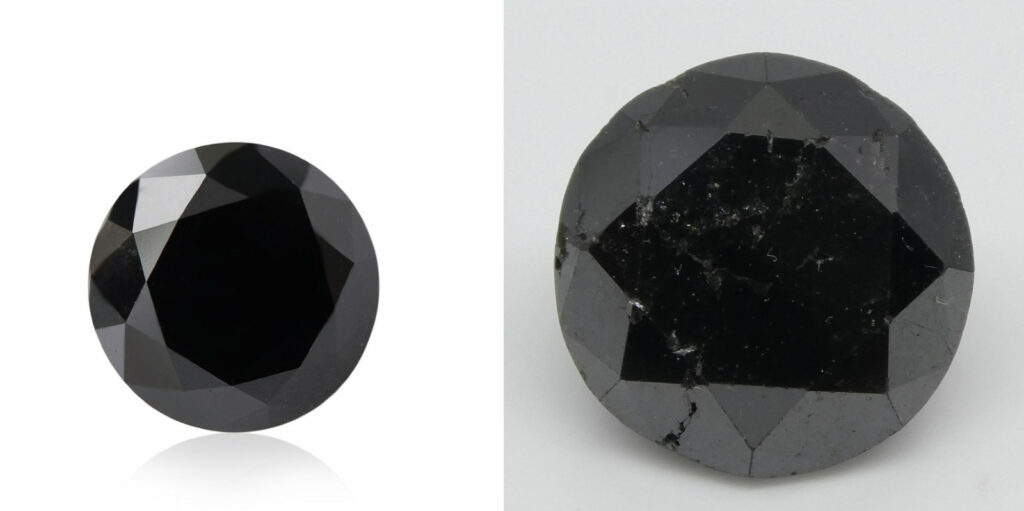
Smooth surface vs. Cracked surface on a black diamond
You see all those fractures all over the stone on the right? Those are surface-reaching inclusions. Not only do these fractures really disrupt the beauty of this gem, they also put your stone at risk for chipping and cracking. Nooooo! Now, take a look at the gem on the left. See its smooth surface? All the inclusions are inside the gem. You get that midnight-black look you’re going for, without any disruption in beauty or to your stone.
Pro Tip: You’re going to see black diamonds listed from $100-$5,000/carat online. There’s a reason they’re being sold at $100/carat – they’re either dangerously included, treated, or (more likely) dangerously included stones that are also treated. Beware of “stock” photos which look like a beautifully smooth gem. At that price? That’s not what’s actually being sold.
The next thing to look for is even color. Because natural black stones attain their color from inclusions, sometimes that color can be a little patchy. This is where those “salt and pepper” diamonds come into play. So, to get that pure-black look, always carefully view every surface area of your gem to make sure the color is even, including from the side (you don’t want to turn your ring sideways and see a clear patch!)
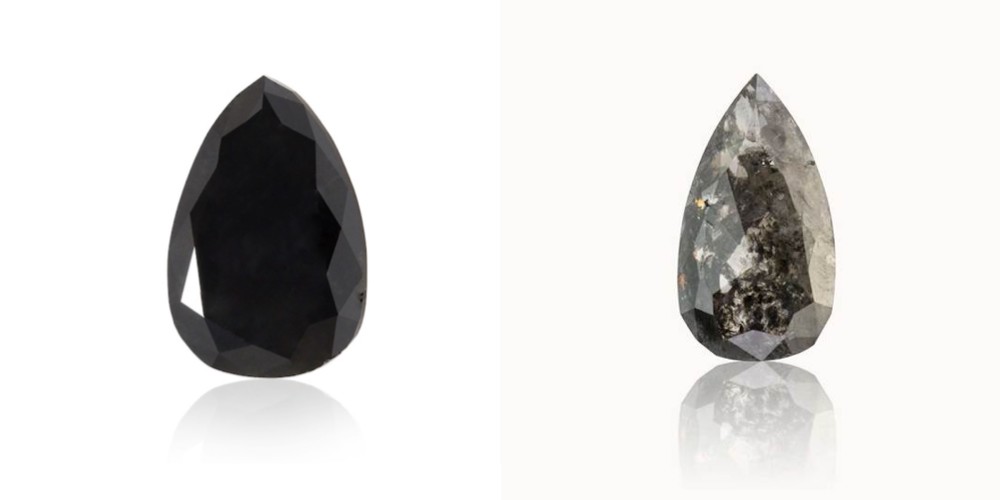
Left: Pure black diamond. Photo by- Leibish & Co | Right: Salt and pepper diamond. Photo by- Turnsmith Jewelers
Black diamonds come in all sorts of shapes! But, “cut” isn’t just the shape of your stone. It’s also how well its faceted. Unlike traditional white diamonds, the “cut” of a natural black stone isn’t about light return and sparkle. That is because black gems do not sparkle the same way (due to not being see-through). Instead, natural blacks give off a more metallic-like shine. As a result, facet symmetry is super apparent and really important.
To look for “facet symmetry,” draw an imaginary line down the center of your stone. Now, compare the left side to the right side. Do all the little cuts all over your stone (its “facets”) mirror each other? If not, move on. The symmetry of these cuts will determine how high quality your stone looks.
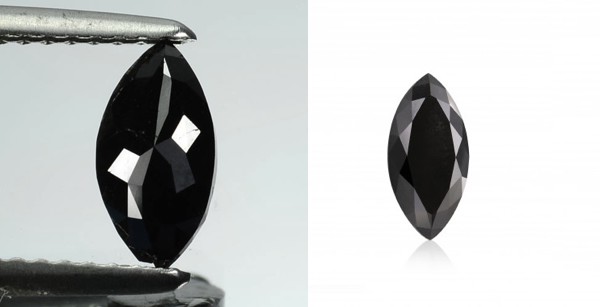
Left: Asymmetrical facets. | Right: Symmetrical facets.
Just as a reminder – always confirm treatment in your stone! Because treated diamonds are SO much less expensive than natural diamonds, you really want to know what you’re buying. If you want a treated diamond, certification is less important. However, if you want a natural black, always make sure to choose a certified diamond to ensure it has not been irradiated! Choosing a certified stone is the best way to confirm you’re actually buying a natural diamond. Certification additionally protects your investment by providing independent credible evidence to your insurer and any future owners that the gem is natural.
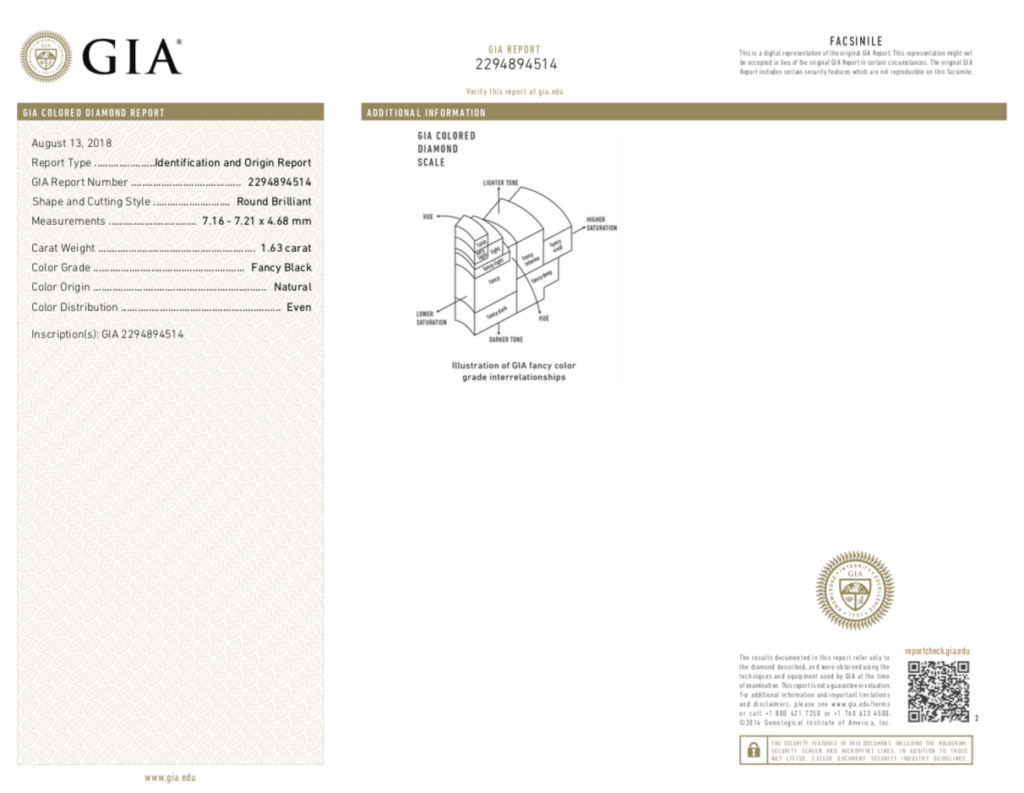
Example of GIA black diamond grading report.
A black diamond engagement ring symbolizes confidence and strength. It says you don’t need approval from anyone! Great styles for couples who love a great dark look include:
Couples looking for a fashionable setting will like black diamond engagement rings with halos and large center stones. There are plenty of options available! Couples can choose a large black center stone in almost any shape, from round to oval to princess. In addition, couples can choose a black halo, a white halo, a combination of each, or even add color!

Those that want an edgy, dark look will love more a more gothic engagement ring style. Look for pointed shapes like pears and marquise, and set them in cool metals like white gold and platinum. Another gothic engagement ring tip: check out black rhodium (a coating for white gold!)
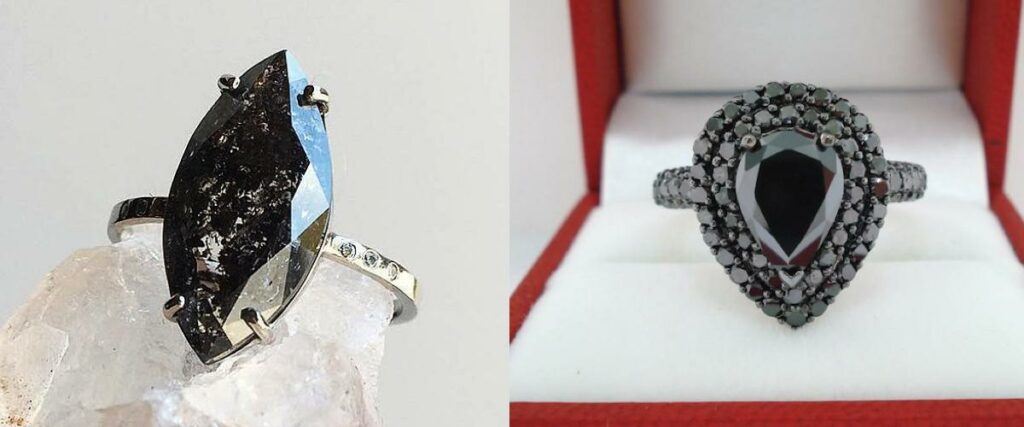
The ultimate expression of Art Deco fashion is black and white. Additionally, Art Deco loved everything square and rectangular. So, classic Deco couples should look for Asscher cuts and Emerald cuts in mixed black and white diamonds.
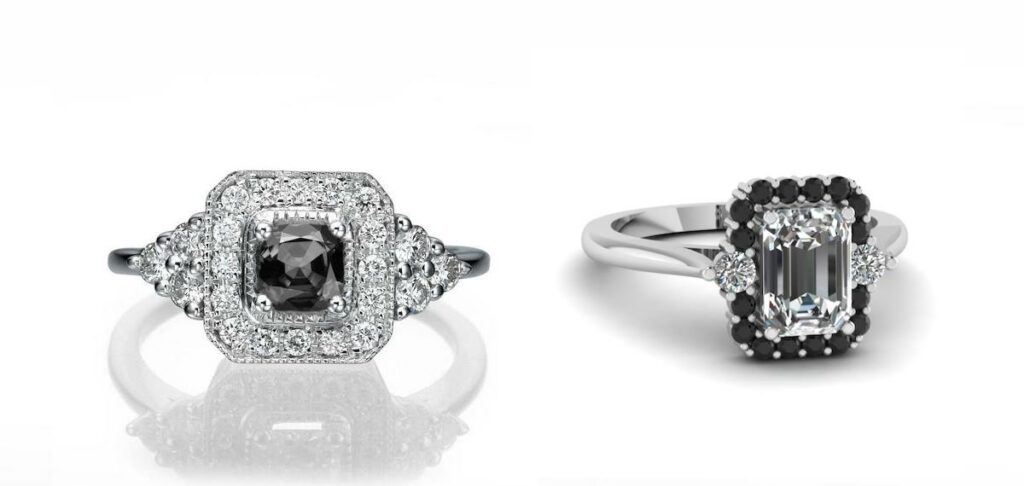
Those looking for the best price will find it in treated diamonds. However, these stones are not very “valuable” in terms of investment quality. On the other hand, natural black diamonds are rare, while also being much more affordable than white diamonds. So, we would suggest that the best value in terms of price AND investment quality is a natural black diamond. Interestingly, in sizes over 3 carats, per carat pricing (like per pound pricing at the deli) does not continue to rise in black diamonds (unlike white diamonds, where per carat price skyrockets). So, if you choose a five (5) carat black diamond, you’ll pay the same per carat price of a three (3) carat. As a result, those looking to go big can go huge at a remarkable value!
It would be my pleasure. My name is Corinne, I’m the gemologist, and you can reach me at care@doamore.com. Email me about your vision – are you looking for a flashy ring? A Deco masterpiece? An edgy, gothic engagement ring? and I’d be happy to perform a custom search for the perfect black diamond for your special ring!
Verifiably Ethical & Sustainable
Guaranteed 1:1 Impact
Personalized 1:1 Customer Service
handcrafted & american-made
you before us, always
Verifiably Ethical & Sustainable
Guaranteed 1:1 Impact
Personalized 1:1 Customer Service
handcrafted & american-made
you before us, always
Thoughtfully crafted, made to last, and designed for life's most meaningful moments. LEARN MORE
Diamonds, Gemstones, & Metals
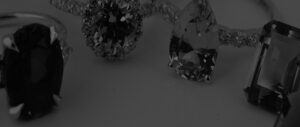
Every piece of Do Amore jewelry begins by not hurting the world. All our natural diamonds are either ethically sourced in Canada, recycled to eliminate additional demand, or accompanied by a blockchain ledger showing every hand your diamond passed through, proving your stone is truly conflict-free.
We also offer sustainable lab-created stones and guarantee all precious metals are recycled to eliminate the environmental impact of mining. Since March 2022, we carry absolutely no Russian diamonds and continue to urge the industry to follow suit.
Clean Water
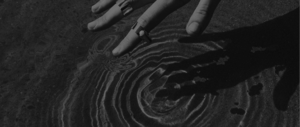
We desire to deepen the well of love in the world. We guarantee that every single purchase—whether engagement ring, wedding band, or piece of jewelry—directly impacts one person’s life by giving them access to clean water.
We do this by directly matching jewelry purchases to people in communities to ensure our funding has a one-to-one impact. We also show you the exact GPS coordinates and a photo of the water well your ring or piece of jewelry helped fund.
Customer Service
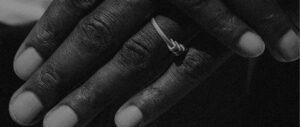
As a small, 100% founder- and employee-owned team, one-to-one encounters are at the heart of our values. Whichever way you want support throughout your engagement ring or jewelry purchase process, our team is here to accommodate you.
From high-touch to hands-off, video calls to text messages, you have our dedicated, responsive team on your side from the moment you start your search, to the day your well is built, to the time we meet again.
Engagement Rings, Bands, & Jewelry
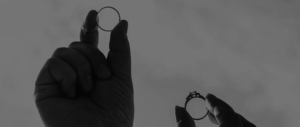
Every Do Amore design, whether one of our own or unique to you, is beautifully handcrafted in America and made specifically for you. Each ring is made to order, every time.
From classic to custom, you have the option to select from dozens of gorgeous settings or work with our design team to create something entirely bespoke. Plus, you are always covered for free inspections, polishing, cleaning, stone tightening, rhodium-plating, and resizing for life.
Our Promise

We care about what matters most to you, not what’s easiest for us. If it’s a minor change to a setting or arriving at a completely custom design, we work to ensure you get precisely what you love.
From statement-making to understated, we have options at any price point. Plus, you always have our team on your side searching to bring you every stone within your specifications. We also offer 60-day returns and a limited lifetime warranty to cover you in the rare event of a manufacturing defect.